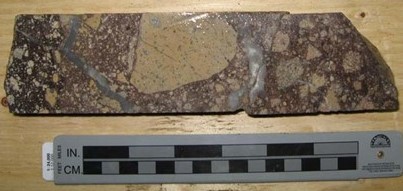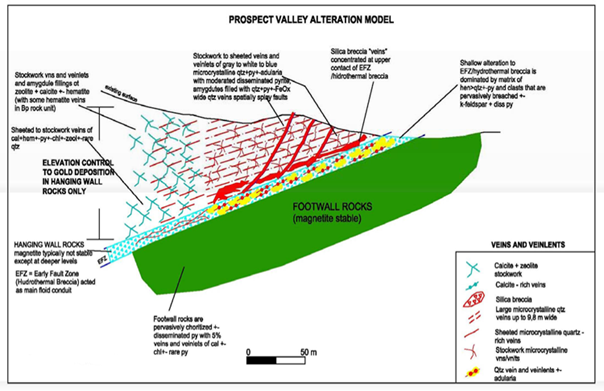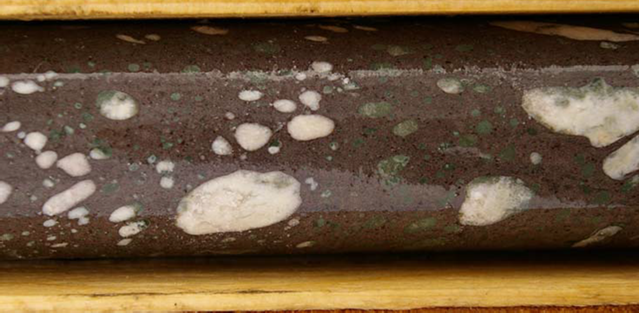
The Prospect Valley Low-Sulphidation Epithermal Gold Mineralization Hosted Within a Hanging Wall Sequence of Amygdaloidal Basalt, Andesitic Basalt and Andesite.
Author: Victor Jaramillo (P.Geo)
Read this article on LinkedIn
From 2007-2008 the author was Exploration Manager for Spire Ventures and directed all exploration work at the Prospect Valley Property at that time. The Prospect Valley Property is located in the Nicola Mining Division of south-central British Columbia, Canada, one of the locations where Mr. Jaramillo has technical and geological mining expertise. Currently, Mr. Jaramillo is the principal of Discover Geological Consultants, a mining consultancy providing NI-43-101 technical reports, and offering expertise in mineral project exploration, development, and evaluation.
The Prospect Valley Gold Property
The Prospect Valley property lies within the Southern Intermontane Tectonic Belt of the Canadian Cordillera. Lithologies within the Prospect Valley region include successions of Mesozoic (248-65 Ma) to Tertiary (65-1.8 Ma) volcanic and sedimentary rocks, which have been intruded by plutons of various compositions and ages from Late Triassic and/or Jurassic to Miocene(?). Locally thick deposits of Pleistocene and recent glacial till and alluvium are prevalent in all the major creek or river valleys.
The focus of exploration on the Prospect Valley property has been bulk-mineable low-sulphidation epithermal gold mineralization in basalts, formed as quartz + pyrite ± adularia vein stockworks above a major shallow- dipping fault zone.
Low-sulphidation epithermal deposits are precious metal-bearing quartz veins, stockworks and breccias formed from boiling of volcanic-related hydrothermal to geothermal systems. Emplacement of mineralization takes place at depths ranging from near-surface hot spring environments to ~1 km, from near neutral pH chloride waters with metal deposition through boiling and fluid mixing. Gangue mineralogy is dominated by quartz and/or chalcedony, accompanied by lesser and variable amounts of adularia, calcite, pyrite, illite, chlorite and rhodochrosite.
Most of the Prospect Valley property is underlain by the Spius Creek Formation and the Pimainus Formation of the mid-Cretaceous Spence’s Bridge Group that are dominated by basaltic to andesitic flow rocks with lesser volcaniclastic and epiclastic units. The southwest-striking Early Fault Zone (EFZ) unit was identified in 2007 as a major control for gold mineralization at the South and North Discovery Zones. The EFZ is 1 to 12 m thick (true thickness), dips moderately to the southwest at 30 to 45º, and may be traced consistently in drill holes from the South to the North Discovery Zones for over 1.7 km in strike length.
The EFZ unit is interpreted as a fissure/structural vein that has characteristics similar to fault breccia and hydrothermal breccia. The EFZ/hydrothermal breccia unit cuts multiple rock types within the Spence’s Bridge Group and separates two distinct volcanic rock sequences: a hanging wall sequence of intercalated amygdaloidal basalt, mafic-phyric basalt, andesite flows; and a footwall sequence dominated by mafic-phyric basalt and volcaniclastic rocks dominated by tuff breccia and lesser interbedded sequences of crystal tuff and lapilli tuff.

The rocks within the South and North Discovery Zones are separated into four packages of rocks that are distinguished relative to their position with respect to a persistent southwest-striking fault zone called the Early Fault Zone (EFZ): (1) early fault zone/hydrothermal breccia; (2) footwall rocks; (3) hanging wall rocks; and (4) late dike rock that cuts both footwall and hanging wall rocks.
Hydrothermal alteration, quartz veins, and related gold mineralization in the North and South Discovery Zones are focused in the Early Fault Zone/hydrothermal breccia unit and the overlying rocks located in the hanging wall. Hydrothermal alteration is zoned laterally and vertically away from the Early Fault Zone. Microcrystalline quartz veins and related Au mineralization are associated with argillic/sericitic and potassic alteration, pervasive silicification, weak to moderate disseminated pyrite, and/or weak hematization that occurs in and proximal to the Early Fault Zone in the hanging wall rocks. The area containing microcrystalline quartz veins and related gold mineralization form a mappable/geochemical target zone 1.7 km long by 140 to 230 m wide with the EFZ forming a sharp “hard” eastern boundary and lower boundary to the target. The gold mineralization correlates strongly with up to five different documented styles of quartz veins. These veins typically have a wavy character and form stockwork zones that approach crackle breccia textures. An alteration assemblage dominated by hematite, zeolite, and calcite with rare chlorite and quartz occurs distal to the Early Fault Zone and at depth within the Early Fault Zone. Microcrystalline quartz-rich veins significantly decrease in size and density down-dip along the Early Fault Zone based on fan drilling on cross-sections mostly in the North Discovery Zone. Propylitic alteration is pervasive in the footwall of the Early Fault Zone. The footwall rocks consisting of mafic-phyric basalt and tuff breccia units are strongly altered to chlorite.
Amygdule mineral fillings in the hanging wall Basalts of the Early Fault Zone are usually laterally zoned relative to the Early Fault Zone. Proximal to the Early Fault Zone, the amygdules are replaced by drusy quartz, pyrite, and locally iron-oxide (after pyrite). At moderate distances away from the Early Fault Zone, the amygdules are replaced by calcite with lesser quartz ± chlorite ± pyrite. At distal locations from the Early Fault Zone, amygdules are typically replaced by zeolite + calcite ± chlorite ± montmorillonite ± celadonite. The amygdules can be filled with more than one alteration mineral and may exhibit zoning from the core to the rim.

Gold mineralization at the South and North Discovery Zones is strongly associated with the presence of sheeted to wavy stockwork quartz veins and veinlets, pervasive silicification, siliceous breccia, sericitic/argillic alteration, potassic alteration (microcrystalline K-feldspar flooding of the volcanic rock and adularia in the veins), and low amounts of pyrite (generally <5% by volume). Gold concentrations can be highly variable throughout an individual drill hole but appear to be consistent over large thicknesses in a limited vertical elevation range. Drill data has demonstrated strong geological continuity of the Early Fault Zone target at depth and along strike but indicates that gold mineralization is limited to shallower horizons (up to 66 m of vertical thickness) in the hanging wall of the Early Fault Zone.


Conclusion
The 2007 diamond drill sampling program reported numerous anomalous to locally economic gold- enriched sample intervals. The gold enriched intervals are most highly concentrated over several meters’ width, located above and near the EFZ contact. Most of the more strongly anomalous zones contain gold values grading between 0.3 to 1.0 g/t Au, with local increases varying between 2.0 to 12.3 g/t Au.
Vancouver Mining Consultants
Victor Jaramillo is currently the principal of Discover Geological Consultants Inc. a consulting firm that offers expertise in mineral project exploration, development, and evaluation gained over 30+ years in leadership roles within the mining industry. Our abilities span legal and regulatory compliance, financial management, and technical reporting. This unique combination of deep technical skills and years of experience allow us to deliver on a wide range of mineral projects. If you’re looking for NI-43-101 Technical reports, Mineral Resource Estimates, Mineral Exploration and/or Drilling program management contact us today!

